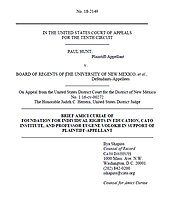Learn more about Cato’s Amicus Briefs Program.
You do not surrender your First Amendment rights by going to school, nor may a school punish you for publishing your political opinions on the internet. In Hunt v. Board of Regents of the University of New Mexico, the federal district court in New Mexico granted qualified immunity to a medical school board that censured and academically disciplined a student for posting an impassioned anti-abortion message on his Facebook page. The board members were given qualified immunity because there was no clear precedent defining First Amendment protections in situations where students’ online speech conflicted with university standards of “professionalism.”
Qualified immunity shields public officials from being liable for violating someone’s constitutional rights. In order to defeat qualified immunity, a plaintiff must show that the official violated a “clearly established” constitutional right. This is interpreted very narrowly. Even minor differences between a case and previously decided cases will exonerate a government official. In Hunt, the lower court focused on factual differences between this case any others involving students. It held that, because there were no clear cases involving student internet-speech and universities, the board members could not have known they were violating Mr. Hunt’s rights when they demanded he change his message. Cato has joined the Foundation for Individual Rights in Education and UCLA law professor Eugene Volokh in asking the Tenth Circuit to overturn the district court’s grant of qualified immunity.
We argue that the lower court’s ruling is not only substantively wrong, but it is also a procedurally dangerous catch-22. The Supreme Court has clearly established that students enjoy the freedom of speech and that freedom of speech extends to the internet. The lower court need only have put those two lines of reasoning together to see what protections Mr. Hunt should have enjoyed here. Instead, they narrowly framed the question in a way that all but guaranteed that qualified immunity would attach.
The grant of qualified immunity in this case also presents a serious threat students’ ability to redress constitutional violations and prevent continued abuse. When the court only considered the case’s unique facts to check if there was a rule, it made the development of new constitutional law almost impossible. This is unusual because the very concept of judicial review is that courts are expected to take established principles and apply them to new facts. The court’s refusal to do so here effectively creates a catch-22 where courts will not ever be able to clarify situations where schools violate student rights. In essence, the court declined to clarify the law because there were no similar cases that clarified the law. But there will never be similar cases that clarify the rule until some court is willing to do so. Plaintiffs must produce precedent even as fewer courts are producing precedent. Important constitutional questions go unanswered precisely because those questions are yet unanswered.
Under the lower court’s holding, future constitutional violations will be left without remedy, and lasting uncertainty over First Amendment rights will chill campus speech on matters of public concern. As in the instant case, public colleges continue to violate student rights to limit controversy or criticism. When students face a series of virtually insurmountable hurdles to get a judicial determination, student speech is at risk. Judicial clarity is required to keep students’ First Amendment rights secure. The Tenth Circuit should clearly establish, and re-affirm, that students do not surrender their free-speech rights at the doors of academia, and a school certainly has no right to reach out beyond its borders into the internet to punish students for engaging in political speech.

This work is licensed under a Creative Commons Attribution-NonCommercial-ShareAlike 4.0 International License.
